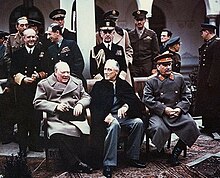The enemy of my enemy is my friend
From Wikipedia, the free encyclopedia
The proverb the enemy of my enemy is my friend suggests that two parties can or should work together against a common enemy. Although it is often described as an Arabic proverb, there is no evidence of such an origin. The earliest known expression of this concept is found in a Sanskrit treatise on statecraft dating to around the 4th century BC, while the first recorded use of the current English version came in 1884.[1][2]
The proverb is sometimes phrased as the enemy of mine enemy is my friend or my enemy's enemy is my friend.
Foreign policy[edit]
The king who is situated anywhere immediately on the circumference of the conqueror's territory is termed the enemy.
The king who is likewise situated close to the enemy, but separated from the conqueror only by the enemy, is termed the friend (of the conqueror).—Kautilya, Arthasastra
During the Second World War, said foreign policy was often on display within the Allied powers. On the European side of the war, tension was common between the Western Alliesand the Soviet Union. The fiercely anti-Communist British Prime Minister Winston Churchill declared that, "if Hitler invaded Hell, I would make at least a favourable reference to the Devil in the House of Commons," in support of British aid to Soviet forces.[4] Like Churchill, U.S. President Franklin D. Roosevelt was wary of Joseph Stalin and his dictatorial regime, but realized the Soviets were necessary for the Allied war effort.[5] The Soviet leader reciprocated these feelings towards his Western allies, as he also viewed the alliance as necessity in order to defeat the Nazi invasion. He was also distrustful of the Western Allies and feared that they would negotiate a separate cease-fire with Nazi Germany.[6] In addition to the European World War II Allies, the doctrine of "the enemy of my enemy is my friend" was also seen during the Chinese campaign of the war as Communist andNationalist troops, which had been fighting each other in the Chinese Civil War, joined forces to fight Japanese aggression.[7]
The doctrine was also used extensively during the Cold War between the West and the Soviet Union. The Soviets and the Chinese aided North Korea during the Korean War, and the Viet Cong/North Vietnamese during the Vietnam War to oppose American foreign policy goals.[8] Likewise, the United States and its allies supported the Afghan Mujahideenafter the Soviet invasion in the hopes of thwarting their goals there.[9] In the Third World, both superpowers were willing to support regimes whose values were at odds with the ideals espoused by their governments—capitalism and democracy[citation needed] in the case of the United States, and the Marxist–Leninist interpretation of Communism in the case of the Soviet Union. The United States government was willing to support undemocratic regimes in order to oppose the spread of Communism, such as Mobutu Sese Seko inZaire and Augusto Pinochet in Chile.[10][11] Although not directly related to the global Western/Soviet power struggle, the United States also backed Saddam Hussein during theIran–Iraq War due to the anti-American Iranian Revolution of 1979.[12] Similarly, the Soviet Union supported a handful of nations with overtly anti-Communist governments in order to oppose American foreign policy, most notably Gamal Abdul Nasser in Egypt.[13] The Soviets also backed India to counter both the pro-American Pakistani government and the People's Republic of China (following the Sino-Soviet split)—despite India having a democratic government (see India – Russia relations and references therein). Similarly, China, following the split, lent support to nations and factions who embraced an anti-Soviet, often Maoist form of Communism, but whose governments nonetheless embraced Sinophobicpolicies at home, such as the Khmer Rouge.
See also[edit]
References[edit]
- ^ http://books.google.dk/books?id=FFJz72h5qjUC&pg=PA520&redir_esc=y#v=onepage&q&f=false
- ^ Forrest Wickman (16 May 2013). "Fact-Checking Spock: Was the “Enemy of My Enemy” Guy Really Killed by His “Friend”?". Slate. Retrieved 24 January 2014.
- ^ Kautilya "Arthasastra" translated by R. Shamasastry, Third Edition, Weslyan Mission Press 1929 Mysore, p. 296.
- ^ Sir Winston Churchill: Biographical History Churchill College, Cambridge
- ^ Stefan, Charles G.Roosevelt and the Wartime Summit Conferences with Stalin. University of North Carolina.
- ^ Kenez, Peter (2006). A History of the Soviet Union from the Beginning to the End (2nd Ed.). Cambridge University Press.
- ^ Chinese Civil War. GlobalSecurity.org.
- ^ Poroskov, Nikolai (April 30, 2005). The USSR was actively involved in the war in Vietnam 30 years ago. Pravda.
- ^ No Regrets: Carter, Brzezinski and the Muj.
- ^ French, Howard W (September 8, 1997). Mobutu Sese Seko, Longtime Dictator of Zaire. The New York Times.
- ^ Kornbluh, Peter (October 24, 1999).Still Hidden: A Full Record Of What the U.S. Did in Chile. The Washington Post.
- ^ Dobbs, Michael (December 30, 2002). U.S. Had Key Role in Iraq Buildup. The Washington Post.
- ^ Anti-Communist Rally. June 23, 1961. TIME Magazine.

No comments:
Post a Comment